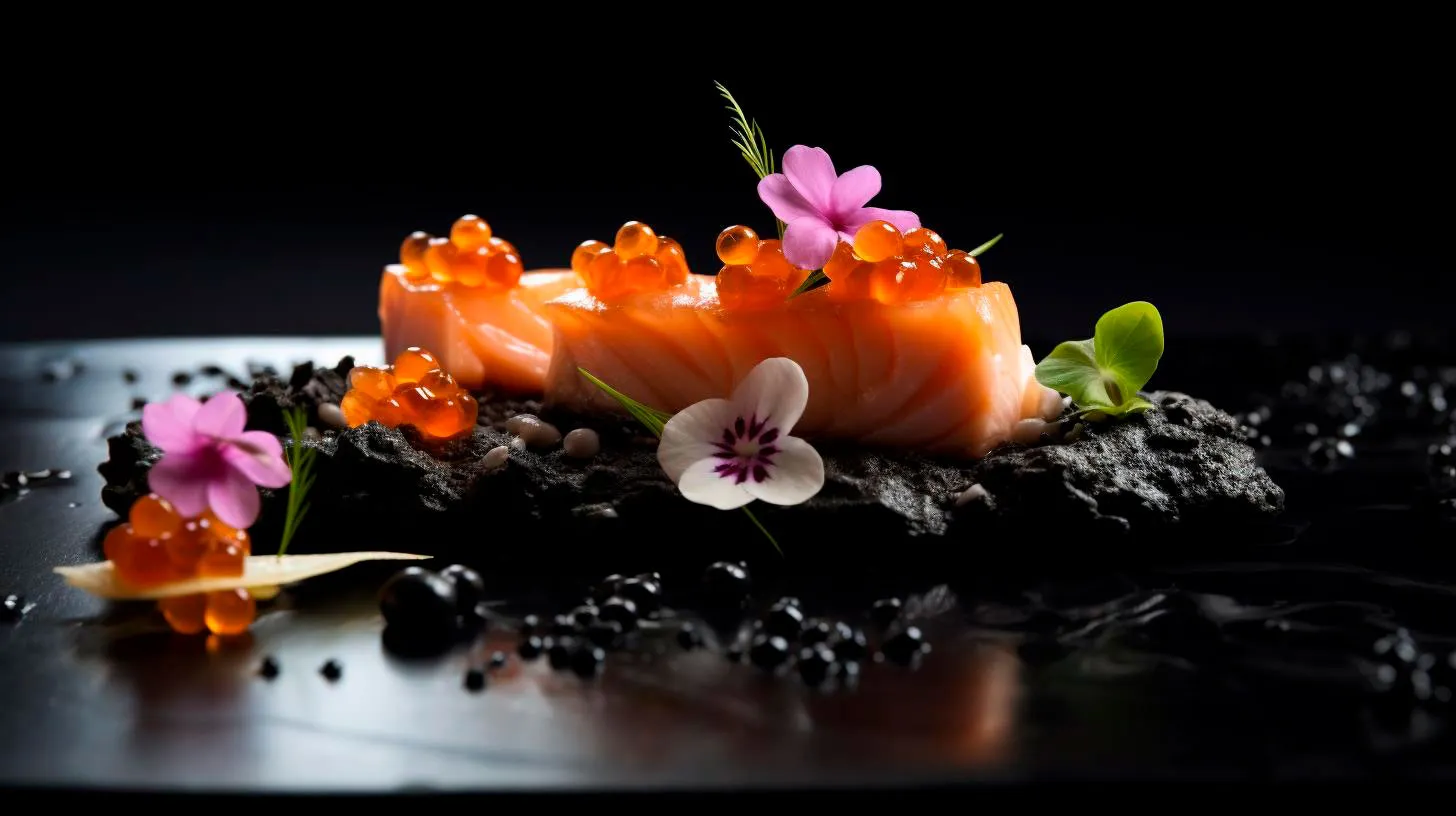Exploring the Multisensory Pleasures of Sushi through Textures
The Role of Textures in Sushi
Sushi is not just about taste; it’s a multisensory adventure that engages your senses in various ways. One such aspect is the textures found in different sushi components. From the sticky rice to the crispy seaweed and the smoothness of the fish, each element offers a unique sensation that adds depth and complexity to every bite.
- Sticky Rice: The foundation of sushi, the sticky rice provides a soft and slightly chewy texture. It acts as a neutral backdrop that allows other flavors to shine.
- Crispy Seaweed: The outer layer of sushi rolls, which is often made of Nori seaweed, provides a delicate crunch. It contrasts with the softness of the rice and adds a satisfying texture to the overall experience.
- Fresh Fish: Whether it’s buttery tuna, silky salmon, or delicate white fish, the texture of the fish is a key component of enjoying sushi. Each variety offers a different mouthfeel, enhancing the overall eating experience.
- Creamy Avocado: Avocado is a popular ingredient in sushi due to its creamy texture. Its smoothness adds a pleasant contrast to the other ingredients, creating a harmonious blend of flavors and textures.
- Crunchy Tempura: In some sushi preparations, tempura is used for an added crunch. The light and crispy texture of tempura adds a delightful surprise within the sushi roll.
Understanding the various textures in sushi allows us to appreciate this art form on a deeper level. Just like a symphony, sushi incorporates different elements to create a harmonious experience that stimulates multiple senses.
Advantages of Exploring Sushi Textures
Exploring the multisensory pleasures of sushi textures not only enhances the overall dining experience but also offers some significant advantages:
- Enhanced Flavor Perception: The combination of different textures in sushi can heighten your perception of flavors. It adds complexity to each bite, allowing you to fully experience the nuances of the ingredients used.
- Textural Variety: Sushi provides a wide range of textures, from soft and chewy to crispy and crunchy. This variety keeps your palate engaged and prevents taste fatigue, making every bite exciting.
- Unique Eating Experience: The exploration of sushi textures elevates the overall dining experience, transcending it from a mere meal to an adventure for the senses. It adds a layer of excitement and enjoyment that is unique to sushi.
Moreover, appreciating the textures in sushi is not limited to only seasoned sushi connoisseurs. It is an accessible aspect of sushi that can be enjoyed by everyone, whether you are a first-time sushi eater or a regular at your local sushi spot.
Incorporating Sushi Textures into Your Dining Experience
If you’re looking to fully explore the multisensory pleasures of sushi textures, here are a few tips to enhance your dining experience:
- Take your time: Savor each bite and pay attention to the textures as you chew.
- Experiment with different sushi varieties: Try different types of sushi to appreciate the wide range of textures they offer.
- Combine different ingredients: Create your own sushi combinations by mixing textures, such as pairing creamy avocado with crispy tempura.
- Engage with your senses: Close your eyes, focus on the various textures, and let your senses guide you through the experience.
By incorporating these practices into your sushi dining experience, you will unlock a whole new dimension of enjoyment and appreciation for this beloved cuisine.
Key Takeaways
Sushi is not just a feast for your taste buds; it’s an exploration of textures that engages multiple senses. Understanding the role of textures in sushi allows us to fully appreciate this culinary art form. The advantages of exploring sushi textures include enhanced flavor perception, textural variety, and a unique dining experience. By taking your time, experimenting with different sushi varieties, and engaging with your senses, you can unlock the full multisensory pleasures that sushi has to offer. So, next time you indulge in a sushi feast, be sure to relish the textures and let them transport you to a world of culinary delight.
Unleashing the Artistry of Sushi: A Sensory Journey of Dynamic Textures
So, what sets sushi apart from other cuisines? Let’s dive deeper into the world of sushi and explore the artistry behind its creation.
The Art of Sushi Making
Sushi making is an intricate process that requires skill, precision, and creativity. Every small detail, from the quality of the ingredients to the technique used, contributes to the final masterpiece. Here are a few key steps involved in the art of sushi making:
- Selection of Fish: The foundation of any great sushi lies in the freshness and quality of the fish. Sushi chefs meticulously handpick the finest cuts, ensuring that each piece meets their exacting standards.
- Sushi Rice: The rice used in sushi is not your ordinary rice. Specially seasoned with vinegar, sugar, and salt, sushi rice provides the perfect texture and flavor balance to complement the fish.
- Slicing and Assembling: Slicing the fish into precise, uniform pieces requires years of practice and expertise. The sushi chef’s steady hands delicately place the fish atop a small mound of seasoned rice, forming the iconic sushi bite.
- Garnishes and Accompaniments: Sushi is often adorned with garnishes like wasabi, ginger, and soy sauce. These accompaniments enhance the flavors and provide a well-rounded taste profile.
The Sensory Experience
Sushi is not just about taste; it is a multi-sensory experience that engages all your senses.
- Visual Delight: The presentation of sushi is a work of art in itself. Vibrant colors, intricate plating, and attention to detail make each dish visually appealing.
- Aromas that Mesmerize: As the sushi arrives at your table, an enticing aroma fills the air. The combination of freshly sliced fish, vinegared rice, and subtle flavors whets your appetite.
- Exquisite Textures: From the melt-in-your-mouth feel of fatty tuna to the firmness of octopus, sushi offers a wide range of textures. Each bite unveils a new sensation, creating an exciting taste adventure.
- Taste Sensations: Savoring a piece of sushi is like experiencing a symphony of flavors. The delicate balance of umami, sweetness, and acidity dances on your taste buds, leaving a lasting impression.
The Advantages of Sushi
Beyond its artistic appeal and sensory adventure, sushi offers a host of advantages that contribute to its popularity:
- Health Benefits: With its emphasis on fresh ingredients, sushi is a healthy choice. Rich in omega-3 fatty acids, protein, and essential vitamins, it supports heart health and boosts the immune system.
- Customization: Sushi offers endless possibilities for customization. Whether you prefer traditional raw fish or vegetarian options, there is something for everyone.
- Portion Control: Sushi is typically served in small, bite-sized pieces, making portion control easier. This feature makes it an ideal option for those watching their calorie intake or following a specific diet plan.
- Social Dining: Sushi is often enjoyed with friends and family, creating a communal dining experience. Sharing a plate of sushi fosters a sense of togetherness and encourages conversation.
Key Takeaways
Sushi is not just a meal; it is a sensory journey filled with artistry, textures, and flavors. By understanding the intricate process behind its creation and appreciating the fusion of visual, aromatic, and taste sensations, you can unlock a world of culinary delights. The advantages of sushi go beyond its aesthetic appeal, offering health benefits, customization options, and social dining experiences. So, the next time you indulge in a plate of sushi, take a moment to savor each bite and immerse yourself in the artistry of this beloved Japanese cuisine.
The Visual and Tactile Delight of Sushi Dynamic Textures
In this article, we will explore the various textures found in sushi and understand why they contribute to the overall culinary experience.
Dive into the World of Sushi Textures
When it comes to sushi, textures play a crucial role in enhancing the dining experience. Each ingredient has its own texture that adds depth and complexity to the dish. Let’s take a closer look at some prominent sushi textures:
1. Sticky Rice
The foundation of sushi is the sticky rice, which acts as a neutral canvas for other ingredients. The soft and slightly chewy texture of the rice provides a satisfying base for the more delicate toppings. The stickiness of the rice ensures that the sushi holds together and can be easily picked up with chopsticks.
2. Delicate Fish
One of the highlights of sushi is the freshness and tenderness of the fish. High-quality sushi-grade fish, such as tuna, salmon, or yellowtail, have a buttery texture that effortlessly melts in your mouth. The smoothness of the fish contrasts beautifully with the rice, creating an exquisite balance of flavors and textures.
3. Crunchy Vegetables
Vegetables like cucumber or radish provide a refreshing crunch to sushi rolls. These crispy textures add a contrast to the soft rice and fish, creating a harmonious blend of flavors. The vibrant colors of the vegetables also enhance the visual appeal of sushi, making it even more appetizing.
4. Creamy Avocado
Avocado, a popular ingredient in sushi rolls, brings a creamy texture to the dish. Its smooth and buttery consistency adds richness and a velvety mouthfeel. Avocado acts as a binding agent, holding the ingredients together while imparting a subtle nutty flavor.
The Impact of Sushi Textures
The marriage of various textures in sushi elevates the overall dining experience. Each bite offers a symphony of sensations that captivate the palate. The textures of sushi not only create a multi-dimensional experience but also offer several key advantages:
- Enhanced Flavor: The contrasting textures in sushi contribute to a complex flavor profile, hitting different taste receptors on the tongue, resulting in a more enjoyable and satisfying meal.
- Enticing Presentation: The diverse textures in sushi, combined with the meticulous presentation of the dish, create an eye-catching visual appeal. The artistry involved enhances the overall dining experience, making sushi a feast for the eyes.
- Textural Exploration: Sushi allows diners to explore different textures in a single bite. From the soft rice to the delicate fish and crunchy vegetables, every mouthful offers a journey through a range of sensory experiences.
- Indulgent Mouthfeel: The combination of soft, melt-in-your-mouth textures with the crispy and chewy elements adds a luxurious mouthfeel to sushi. It creates a pleasurable sensation that keeps diners coming back for more.
Key Takeaways
Sushi’s dynamic textures make it a unique culinary experience that tantalizes both the senses and the palate. The soft, sticky rice, delicate fish, crunchy vegetables, and creamy avocado collaborate to create a harmonious symphony of flavors and textures. Understanding and appreciating the diverse textures in sushi adds a deeper dimension to the dining experience, ensuring that each bite is a memorable one. So, the next time you savor the delightful artistry of sushi, pay close attention to the textures that make it an exceptional gastronomic adventure!
Sushi Multisensory Marvel: How Different Textures Elevate the Experience
One aspect that sets sushi apart from other dishes is the careful consideration of textures. From the chewiness of the rice to the melt-in-your-mouth qualities of the fish, each element of sushi contributes to a multisensory experience that leaves diners craving for more.
The Art of Sushi Texture
Texture plays a vital role in our perception of food, and sushi masters have perfected the art of harmonizing various textures in a single bite. These textures not only add depth and complexity to the overall experience but also enhance the flavor profile of the sushi. Let’s delve into some of the unique textures that make sushi a multisensory marvel:
1. Softness and Creaminess
Sushi is renowned for its ability to create melt-in-your-mouth experiences. From the buttery texture of toro (fatty tuna) to the silky-smoothness of sea urchin (uni), these soft and creamy textures create a luxurious sensation that is simply irresistible.
2. Chewiness and Resilience
The sticky rice used in sushi not only holds all the ingredients together but also adds a delightful chewy texture. Combined with the resilience of ingredients like octopus or squid, this creates an enjoyable interplay of textures that keeps the palate engaged.
3. Crispiness and Crunch
Tempura and other fried ingredients bring a delightful crunch to sushi rolls. The contrast between the crispy coating and the soft fillings creates a satisfying texture that adds excitement and a different dimension to the overall experience.
4. Smoothness and Firmness
Fish slices atop nigiri sushi offer a unique sensation of both smoothness and firmness. The delicate slice of fish glides effortlessly over the tongue, leaving a trail of subtle flavors, while its firmness provides a satisfying bite.
The Role of Textures in Enhancing Sushi Experience
While taste is undoubtedly important, studies have shown that textures also play a significant role in how we perceive flavors. This is especially true in the case of sushi. The careful curation of various textures not only enhances the overall dining experience but also helps to elevate key flavors and create a harmonious balance. Here are some of the advantages of using different textures in sushi:
- Enhanced Flavor Perception: The combination of different textures stimulates different parts of the tongue, allowing the taste buds to experience a wide range of flavors in a single bite.
- Increased Palate Engagement: By incorporating a variety of textures, sushi activates multiple sensory receptors in the mouth, resulting in a more engaging and enjoyable dining experience.
- Sensory Contrast: The contrast between smooth and chewy, crispy and soft textures enhances the overall mouthfeel, creating an exciting and satisfying experience.
- Visual Appeal: Different textures add visual interest to sushi rolls, making them not only delicious but also visually appealing.
The Key Takeaway: Exploring Sushi Textures
Sushi is undoubtedly a multisensory marvel that tantalizes not only the taste buds but also the eyes and other senses. The careful consideration and combination of different textures add depth, complexity, and excitement to the dining experience. So, the next time you indulge in a plate of sushi, pay attention to the textures dancing on your palate and relish in the chef’s mastery.


